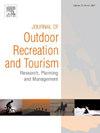Integrating importance- performance analysis into transboundary natural resource management of water trails: Case study at the Chattahoochee river national recreation area water trail in Atlanta, GA (USA)
Abstract
Despite growth in National Water Trail designations year after year along with paddlesports popularity, there is little research on water trail users' experiences within transboundary managed water trail systems. Specifically, there is a lack of evidence regarding which experiential attributes paddlers' find important and how these transboundary zones perform on those attributes. This is problematic because the entities managing transboundary water trail zones do not know if there are common attributes that are important to all water trail users and if they are providing satisfactory water-based recreational experiences based on these expectations. With this gap in mind, this research integrates the domain of Transboundary Natural Resource Management for National Water Trail Systems with the analytical method of Importance-Performance Analysis (IPA) to explicitly compare paddlers’ perceptions (n = 360) of 12 water trail attributes between two different management zones (city park vs. federal National Park Service) of the Chattahoochee River National Recreation Area Water Trail in Atlanta, GA (USA). Results revealed that paddlers within both management zones place high importance on the biophysical attribute of water quality yet are equally dissatisfied with the performance of water quality, a reported decades long issue for the Chattahoochee River. Additionally, paddlers within the National Park Service zone expressed greater dissatisfaction with the lack opportunities available for quiet spaces and paddling in undeveloped areas. Results also indicated that water trail visitors had various levels of expectations and perceptions of river setting attributes that differed by management zones. A focused understanding of how physical, social, and managerial attributes of National Water Trails are perceived by recreational users (e.g., paddlers) aids transboundary natural resource efforts in collaborative decision making to better balance river conservation and recreation management for the future sustainability of National Water Trails.
Management implications
•The increasing popularity of river-based recreation and National Water Trail Systems spanning multiple jurisdictional zones justifies the need to proactively discuss transboundary visitor use management and collaboration across resource management entities (e.g., federal, municipal, private, state, etc.).
•Importance-Performance Analyses (IPA) are a cost-effective and relatively intuitive method for managers across multiple jurisdictions to collaboratively manage the satisfactory performance of recreational setting attributes, while also allowing visitors to express their opinions and perspectives on current and future managerial elements.
•Managers can gain a stronger understanding of the process to evaluate river setting indicators through analytical methods (e.g., IPA) that may save them time and money, as well as provide a logical decision-making pathway to prioritizing action within the Interagency Visitor Use Management Framework (IVUMF) for parks, rivers, and other protected areas.

 求助内容:
求助内容: 应助结果提醒方式:
应助结果提醒方式:


